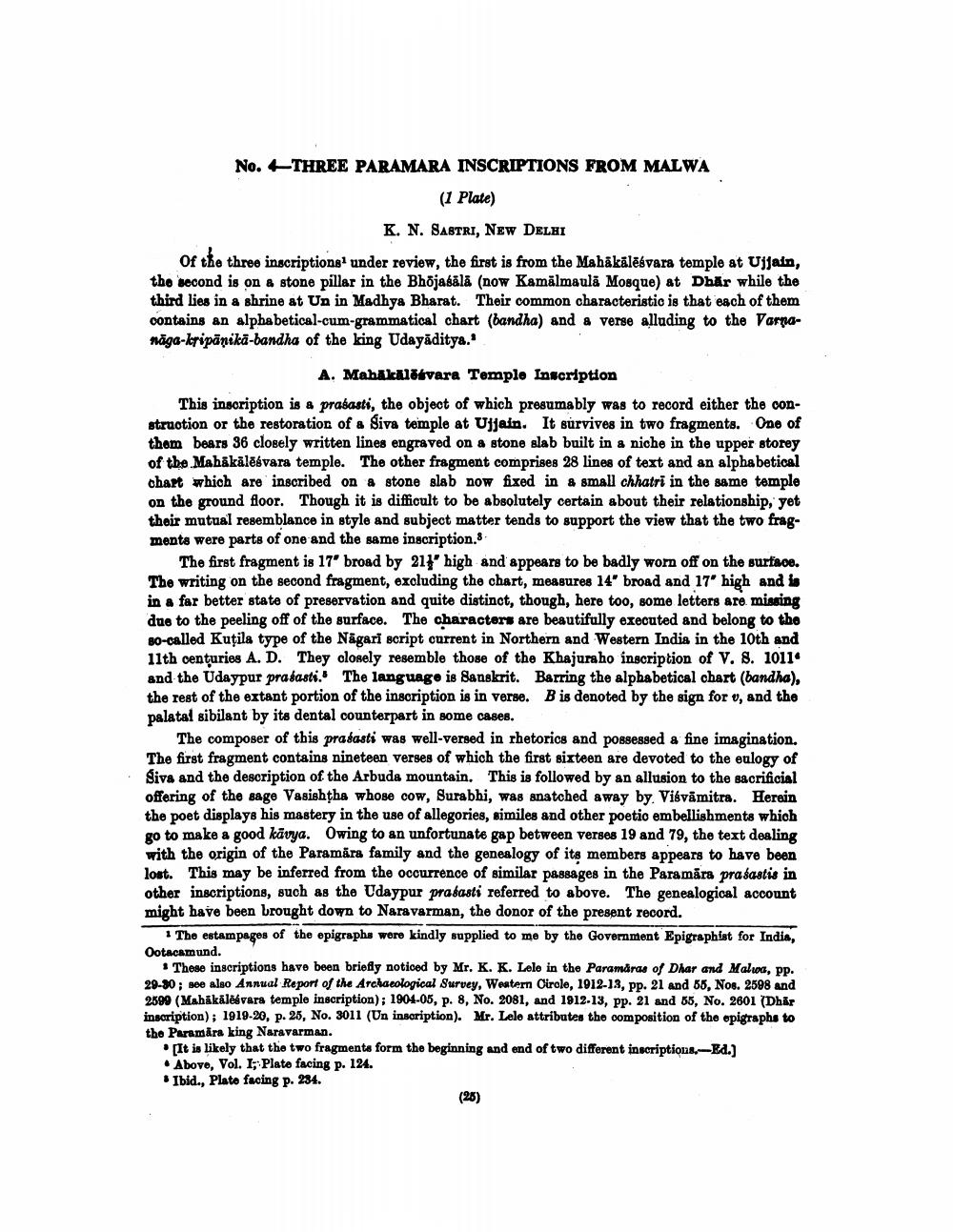________________
No. 4-THREE PARAMARA INSCRIPTIONS FROM MALWA
(1 Plate)
K. N. SASTRI, NEW DELHI Of the three inscriptions' under review, the first is from the Mahākālēsvara temple at Ujjain, the second is on & stone pillar in the Bhojaśālā (now Kamālmaulā Mosque) at Dhär while the third lies in a shrine at Un in Madhya Bharat. Their common characteristic is that each of them contains an alphabetical-cum-grammatical chart (bandha) and a verse alluding to the Varnanāga-kripānikā-bandha of the king Udayāditya.'
A. Mahakali vara Temple Inscription This inscription is a prasasti, the object of which presumably was to record either the construction or the restoration of a Siva temple at Ujjain. It survives in two fragments. One of thom bears 36 closely written lines engraved on a stone slab built in a niche in the upper storey of the Mahakālē vara temple. The other fragment comprises 28 lines of text and an alphabetical chart which are inscribed on a stone slab now fixed in a small chhatri in the same temple on the ground floor. Though it is difficult to be absolutely certain about their relationship, yet their mutual resemblance in style and subject matter tends to support the view that the two fragments were parts of one and the same inscription.8.
The first fragment is 17' broad by 211' high and appears to be badly worn off on the surface. The writing on the second fragment, excluding the chart, measures 14" broad and 17' high and is in a far better state of preservation and quite distinct, though, here too, some letters are missing due to the peeling off of the surface. The characters are beautifully executed and belong to the 80-called Kutila type of the Nagari script current in Northern and Western India in the 10th and 11th centuries A. D. They closely resemble those of the Khajuraho inscription of V. 8. 1011 and the Udaypur prasasti. The language is Sanskrit. Barring the alphabetical chart (bandha), the rest of the extant portion of the inscription is in verse. Bis denoted by the sign for v, and the palatal sibilant by its dental counterpart in some cases.
The composer of this prasasti was well-versed in rhetorics and possessed a fine imagination. The first fragment contains nineteen verses of which the first sixteen are devoted to the eulogy of Sivs and the description of the Arbuda mountain. This is followed by an allusion to the sacrificial offering of the sage Vasishtha whose cow, Surabhi, was anatched away by Visvamitra. Herein the poet displays his mastery in the use of allegories, similes and other poetic embellishments which go to make a good kavya. Owing to an unfortunate gap between verses 19 and 79, the text dealing with the origin of the Paramāra family and the genealogy of its members appears to have been lost. This may be inferred from the occurrence of similar passages in the Paramāra prasastis in other inscriptions, such as the Udaypur prasasti referred to above. The genealogical account might have been brought down to Naravarman, the donor of the present record.
1 The estampages of the epigraphs were kindly supplied to me by the Government Epigraphist for India, Ootacamund.
1 These inscriptions have been briefly noticed by Mr. K. K. Lele in the Paramaras of Dhar and Malwa, pp. 29-30; see also Annual Report of the Archaeological Survey, Western Oirole, 1912-13, pp. 21 and 66, Nos. 2598 and 2599 (Mahákālëkvara temple inscription); 1904-05, p. 8, No. 2081, and 1912-13, pp. 21 and 55, No. 2601 (Dhär inscription); 1919-20, p. 25, No. 3011 (Un inscription). Mr. Lelo attributes the composition of the epigraphs to the Paramāra king Naravarman.
[It is likely that the two fragments form the beginning and end of two different inscriptions.-Ed.) • Above, Vol. 1, Plate facing p. 124. * Ibid., Plato facing p. 234.
(26)




